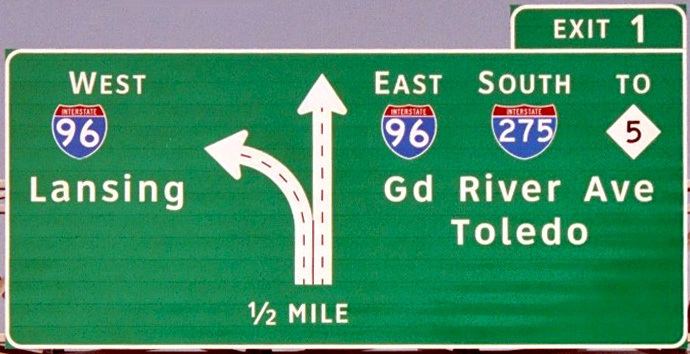Foundry Terminal Design Inc. | ||
 | ||
Designer(s) Donald MeekerJames MontalbanoChristopher O'HaraMartin PietruchaPhilip Garvey | ||
Clearview, also known as Clearview Hwy, is the name of a humanist sans-serif typeface family for guide signs on roads in the United States. It has also been used in Canada, Indonesia, Sri Lanka, and the Philippines. It was developed by independent researchers with the help of the Texas Transportation Institute and the Pennsylvania Transportation Institute, under the supervision of the Federal Highway Administration (FHWA). It was once expected to replace the FHWA typefaces in many applications, although newer studies of its effectiveness have called its benefits into question.
Contents
Initial testing indicated that Clearview was 2- to 8-percent more legible in both day- and night-time viewing than the then-dominant Series E (Modified) on overhead signs, particularly benefiting older drivers, with a six percent increase in legibility distance. A design goal of Clearview was the reduction of irradiation effects of retroreflective sign materials. Reduced nighttime overglow or haloing was expected also to improve recognition rates for computer road sign detection. Unfortunately, these tests compared new signs in Clearview to existing, weathered signs in the existing Highway Gothic font. The new font's apparent legibility "was more due to the fact that older, worn signs were being replaced with nice, fresh, clean signs which were, naturally, more legible." Better testing also revealed that legibility was worse for negative contrast signs (dark lettering on light backgrounds) such as on speed limit and yellow warning signs.
History
The standard FHWA typefaces, developed in the 1940s, were designed to work with a system of highway signs in which almost all words are capitalized. The designers of Clearview sought to create a typeface adapted for mixed-case signage, initially expecting it would be based on an existing European sans-serif typeface. Instead, using a similar weight to the FHWA fonts, a new font was created from scratch. Two key differences are much larger counter spaces, the enclosed spaces in letters like the lower case "e" or "a", and a higher x-height, the relative height of the lower case "x" to the upper case "X". Smaller counter spaces in the FHWA fonts reduced legibility, particularly when the letters glowed from headlight illumination at night. The typeface's general appearance resembles the design of the Transport typeface family, designed by Jock Kinneir and Margaret Calvert in 1957–63 for the British highway sign system.
Official acceptance
Clearview was granted interim approval by the FHWA for use on positive contrast road signs (light legend on dark background, such as white on black, green, blue, brown, purple or red) on September 2, 2004. The FHWA never granted approval for Clearview to be used on negative-contrast road signs (dark legend on light background, such as black on white, yellow or orange), given its inferior legibility to the existing FHWA typefaces in these applications. Despite this, it is used in negative-contrast applications by some agencies. The FHWA also refused to add Clearview to the 2009 MUTCD, citing lack of testing on Clearview's numerals, symbols, and narrower typefaces. In April 2014, FHWA indicated it expected to rescind Interim Approval to use Clearview in the future, eventually doing so in January 2016. However, on June 7, 2016, a committee report commenting on the Transportation, Housing and Urban Development, and Related Agencies Appropriations Act, 2017 (H.R.5394) introduced in the United States House of Representatives was released, which includes language to suspend action on this decision.
Outside the US, Clearview has been adopted in Canada where it has been the standard typeface for signs in British Columbia since 2006 and used for street signs in Toronto. Clearview has been adopted as the standard typeface for road signs in Indonesia since 2014. Since 2016, Ontario's MTO has started using Clearview on some signs on the QEW.
Variants
In addition to its appearance on road signage, a customized version of the ClearviewText typeface was adopted by AT&T for corporate use, including advertising, used from 2006 to 2016. ClearviewText and ClearviewADA are versions of the typeface intended for use in general graphic design and ADA-compliant signage. An example of ClearviewADA in use is signage at Dallas-Fort Worth International Airport.
United States
Between 20 and 30 states have adopted the use of the typeface as of 2013. It was not the official font recommended for use by the FHWA and states were required to request interim approval from the Federal Highway Administration to use the font.
On January 25, 2016, the Federal Highway Administration issued a notice in the Federal Register of the agency's intent to revoke all interim approval for use of the Clearview font in 30 days. FHWA discussed the current state of road signage research and concluded that "the consistent finding among all the research evaluations is that the brightness of the retroreflective sheeting is the primary factor in nighttime legibility." Even worse, significant misunderstandings and misapplications of the interim approval for Clearview were resulting in badly designed non-uniform signs which violated the uniformity central to the Manual on Uniform Traffic Control Devices. Accordingly, the notice concluded, "FHWA does not intend to pursue further consideration, development, or support of an alternative letter style." Existing signs using Clearview may remain as long as they are in serviceable condition.
Canada
The Transportation Association of Canada's MUTCD for Canada allows the use of Clearview, and the Ministry of Transportation of Ontario uses it for positive contrast guide signs. Toronto has been replacing its black-on-white street signs with newer signs that use Clearview since 2004, with exceptions for certain older neighborhoods.
Indonesia
The Ministry of Transportation promulgated a regulation in 2014 to introduce new road signs which would use the Clearview typeface. This new regulation was intended to meet ASEAN Economic Community standards starting in 2015. Previously, road signs in Indonesia had traditionally used FHWA Series fonts since 1993.
